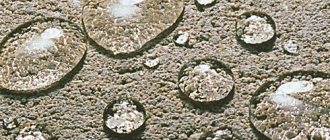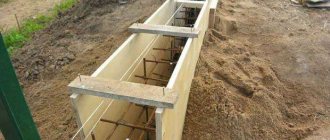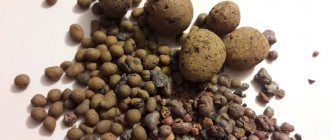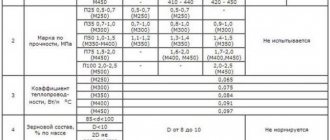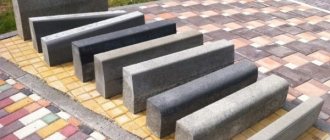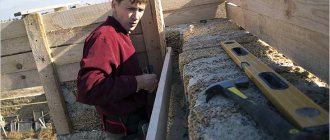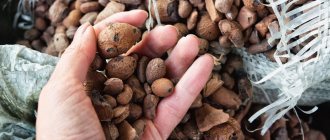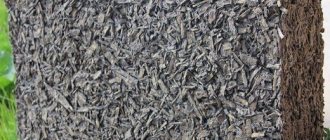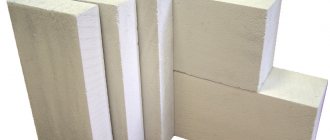The word “expanded clay” itself translated from Greek means “burnt clay”. Already from this name it is clear that to obtain expanded clay, clay must be fired. The essence of the technological process comes down to the following: the prepared clay is subjected to sharp thermal shocks, which makes it possible to achieve porosity of the material and its swelling. Thanks to the melting of the outer shell, the expanded clay is sealed and acquires high strength.
Features of production technology
The raw materials for producing expanded clay are predominantly sedimentary clay rocks, less often metamorphic rocks (argillite, shales and other stone-like rocks).
They have a complex composition and include both clay minerals (hydromica, kaolinite, etc.) and feldspar, quartz, carbonates, organic and ferruginous impurities.
What is this building material made of? The best clays for making expanded clay are those that contain a maximum of 30% quartz.
Whether a particular material is suitable for production is determined through special research. Main requirements for raw materials:
- possibility of swelling during firing;
- fusibility;
- a certain swelling interval.
Sometimes special additives are added to the raw material to increase the swelling coefficient. Organic (solar oil, fuel oil, etc.), ferrous substances, rocks (perlite, alunite, etc.) or artificial substances can be used as an additive.
As a result of processing the feedstock, raw granules of a certain size and composition are obtained. These granules can be heat treated: they are dried, fired and cooled. At the next stage, the resulting material is sorted by density and, if necessary, crushed into smaller fractions. After sorting, expanded clay is ready for storage or shipment to the place of use.
The main stages of expanded clay production:
- delivery of raw materials;
- drying clay;
- roasting of raw materials;
- cooling of granules;
- division into factions;
- transportation and storage.
Marking
Based on the density of the poured thickness, it can be of the following grades:
The number after the letter “M” indicates the density of the poured material in kg per 1 meter. cube
In terms of compressive strength, expanded clay can be:
The higher the number in the brand designation, the higher the longitudinal compressive strength of the granules. Thanks to a fairly simple production cycle, the availability of the necessary equipment and raw materials, and constant high demand in the market, the production of expanded clay turns into a profitable business.
Extraction of feedstock
The expanded clay production process begins with the extraction of clay raw materials in quarries and its transportation to the clay reserve. Development is carried out using open-pit mining using single- and multi-bucket excavators. Extraction of raw materials is carried out along the entire height, without isolating individual layers.
If rock-like rocks such as mudstones or shale are being mined, drilling and blasting is used. Mining of such rocks can be done all year round, while soft rocks are mined only during a certain period.
To ensure continuous production of expanded clay, special frost-resistant clay storage facilities are installed that can hold about a six-month supply of material. Intermediate cones are also used to store clay, in which it is kept in the open air for several months.
Due to the influence of temperature, periodic wetting and drying, the natural structure of the material is partially disrupted. This greatly facilitates the process of further processing of raw materials into a homogeneous mass.
Cons of business
What are the disadvantages of a business producing and selling expanded clay? The first is the need for significant investments of several million rubles. In many ways, it is compensated by potentially high profits, but initially it can be very difficult to find such funds.
Secondly, production requires serious capacity: not only high-quality equipment, but also uninterrupted power and heat supply. By the way, the production of expanded clay consumes a lot of resources (electricity, as well as fuel - gas, coal or fuel oil).
Thirdly, maintaining the work of the workshop will require quite a lot of money - on average, 60% of the total income. Thus, despite the apparent profitability and cheap raw materials, your own expanded clay workshop is quite an expensive pleasure (especially in the first stages of work).
Methods for producing expanded clay granules
There are four main methods for making expanded clay, which differ in their technology:
- dry;
- wet;
- powder-plastic;
- plastic.
The choice of a specific method depends on the quality of the raw materials.
Dry method
This method is the simplest. It is used when dealing with stone-like raw materials. First, it is crushed, then sent to a rotary kiln. This method is most effective if the rock is homogeneous, without harmful inclusions. It is characterized by low costs and low energy consumption.
Wet (or slip) method
Clay is placed in large containers - clay stompers. Then it is diluted with water, obtaining a slip with a moisture content of about 50%. It is pumped into a slurry basin, from where it is transferred to a rotary kiln. Here it is broken down into individual granules. They are dried by the gases that come out of the oven.
The wet method requires high fuel consumption because the slip has high humidity. However, it allows you to clean the raw material from rocky inclusions, introduce additives into it, and obtain a homogeneous mass. It is used in case of high humidity of the feedstock.
The video will tell you in more detail how expanded clay gravel is made using the example of wet production:
Plastic method
This method is most common in the production of expanded clay. It involves moistening loose raw materials and processing them in rollers or clay mixers. The process of making expanded clay is similar to making bricks.
From the resulting mass, cylindrical granules are formed on perforated rollers or belt presses, which are later given a spherical shape. The granules are immediately sent to a rotary kiln or additionally dried in special drums.
The plastic method is more complex, energy- and capital-intensive than the dry method, but it allows you to make a material with better properties. During processing, the natural structure of the raw material is disrupted, it is homogenized, and therefore has a higher swelling coefficient.
Powder-plastic method
First, the dry raw material is brought to a powder state, then diluted with water. As a result, a plastic mass is obtained from which granules are formed. This method is quite expensive, since it is necessary to additionally grind the material. Another disadvantage is the need for additional drying of the granules.
Since the quality of the finished material depends on the quality of the raw granules, the raw materials must be well processed and formed into granules of the same size. Their parameters are set depending on the swelling coefficient of the raw material.
Financial part
The mini workshop can produce from 30,000 to 250,000 cubic meters. meters of expanded clay per year. The volume of products produced depends on the capacity of the production line. Manufacturing the material is a fairly energy-intensive process. But everything pays off with high equipment performance and growing demand for the product. The price of the finished material depends on many factors related to manufacturing technology.
To the cost of expanded clay, you should also add wages to hired workers, wear and tear of equipment, payments to tax authorities, insurance companies, as well as the cost of purchasing raw materials. The total amount of expenses ranges from 600 rubles. The average wholesale cost of 1 cubic meter of expanded clay is 1,100 rubles. As a result, the profit received from 1 cubic meter of expanded clay will reach 400 rubles.
Cheap raw materials and the relatively low price of equipment for the production of expanded clay ensure a low cost of finished products with high heat and sound insulation properties.
Cooling of granules
After firing, expanded clay should be cooled. Cooling begins already in the rotary kiln, thanks to the incoming air. Then it continues in air chutes, drum refrigerators, etc.
The strength of the material depends on how quickly the granules are cooled. If cooling occurs too quickly, the granules may crack. With slow cooling, the quality of the material may decrease as a result of softening and crushing of the granules.
Therefore, expanded clay is cooled to 800-900 degrees immediately after swelling. After this, cool to 600-700 degrees for 20 minutes.
This is necessary so that hardening occurs without high thermal stress, and crystalline minerals are formed, which increase the strength properties of the material. Further cooling can be done quite quickly.
Fractionation and transportation
For fractionation, drum screens are used, which have a cylindrical or multifaceted shape.
Expanded clay is transported within the plant pneumatically or via a belt conveyor. The conveyor method is more popular, since transportation through pipes using air flow leads to damage to the shell and crushing of the granules.
The finished material is stored in a silo or bunker type warehouse. To do this, expanded clay is pre-packed in special moisture-proof bags of various sizes.
Premises requirements: where to place the workshop
Expanded clay is usually sold by the cubic meter. It is produced in very large batches. This requires a lot of space, so the entrepreneur will have to find a large room of 300 square meters. It should be divided into an industrial zone, where all equipment will be installed, and warehouses, where raw materials and finished particles will be stored.
The workshop must be connected to all communications. The smooth operation and quality of the final product depend on this. It is desirable to have good ventilation and convenient access roads for the delivery of raw materials, fuel and shipment of finished expanded clay.
Material Certification
Since the technology for producing expanded clay is quite labor-intensive and complex, any violations can negatively affect the quality of the products. Therefore, when purchasing, be sure to read the certificate of conformity.
There is GOST 9759-76, which specifies the requirements for the parameters of granules, weight and strength of expanded clay. Strength is the main indicator that is taken into account when admitting a material into operation.
Expanded clay is an important component of expanded clay concrete, and no company producing lightweight concrete will purchase it without the necessary documents. In addition, it is widely used in the construction industry. The certificate of conformity provides information about the environmental safety of the material, its compliance with sanitary standards, and provides recommendations regarding storage and transportation.
Main indicators for certification of various fractions of expanded clay
Areas of application
To determine the areas of application of finished products, and at the same time the sales market, you need to answer the question: what is expanded clay needed for? The material, which has high thermal insulation qualities, is widely used in the following areas:
- production of expanded clay concrete structures;
- mixing warm masonry mortars;
- filling lightweight concrete;
- thermal insulation and sound insulation of the base, roof, walls, floors;
- construction of various structures (dams, bridges, roads, etc.);
- pipeline insulation;
- water filtration, plant growing and more.
Today in Russia there are more than 150 factories producing expanded clay, which produce more than 3.5 million cubic meters. meters of material per year. Packaged products are in demand. The cost of a cubic meter reaches 1000 rubles, one bag – from 90 rubles. The price depends on the terms of the contract and the quantity of material supplied.
Equipment for the production of expanded clay
The line for producing expanded clay consists of:
- loosening devices;
- perforated rollers;
- clay mixers;
- drying drums;
- kilns for firing;
- bunkers;
- pneumatic conveyors;
- belt or other conveyors;
- trays;
- gravel sorters, etc.
For primary processing of raw materials, a special crusher is used. It includes a grinding unit, which consists of the following elements:
- blade shafts rotating in the direction of each other;
- rigid frame;
- gear drive;
- receiving bunker.
When the shafts begin to rotate, the raw material is crushed to the required size. A mixer is used to introduce special additives.
The video shows a roller crusher for crushing expanded clay in operation:
The raw materials are fired in a rotating kiln. It has a cylindrical steel body and consists of the following elements:
- loading and unloading head;
- reference station;
- drives;
- furnace end seals;
- crown pair casing, etc.
To install the stove, a foundation is equipped. A welded frame and rollers are used as a support, adjusting their position.
Product packaging:
After passing quality control, the expanded clay is packed. While waiting for their buyer, products can be stored in polypropylene bags and soft polypropylene containers with handles (big bags) of various sizes, or in bulk, in specially equipped warehouses.
In addition to the automated product packaging line, the Serpukhov expanded clay plant also has specially equipped closed rooms where workers manually pour the goods into packages. Packing is carried out in 40-liter bags - fractions 0-5mm, 5-10mm and 10-20mm, in 50-liter fractions 5-10mm and 10-20mm, as well as in big bags with fractions 5-10mm and 10-20mm volume 1, 2.5 and 3m³.
